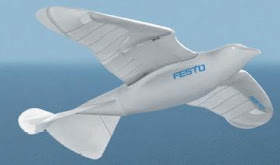The flight of birds has always fascinated the mankind,this is why it is one of the oldest dreams of mankind to fly like a bird.Though a man still can't fly like a bird but the flight of birds has finally been deciphered by Festo,in 2011,through creation of its masterpiece of technology i.e.,SmartBird - the robotic bird.Festo,a company based in Germany,is a leading world-wide supplier of automation technology.A model of SmartBird is shown in Figure 1 below.
Figure 1 : A model of SmartBird
(Image Source : Festo)
A demo flight of this robotic bird is shown in video 1 given below.This video shows that the SmartBird is a a marvellous creation of engineers of Festo's Bionic Learning Network which can not only fly but also can glide and sail through the air.
Video 1 : The Demo-Flight of SmartBird
Figure 1 : A model of SmartBird
(Image Source : Festo)
A demo flight of this robotic bird is shown in video 1 given below.This video shows that the SmartBird is a a marvellous creation of engineers of Festo's Bionic Learning Network which can not only fly but also can glide and sail through the air.
SmartBird is a bionic technology-bearer inspired by the herring gull.A comparison of SmartBird with herring gull is shown in Figure 2 below.
Figure 2 : SmartBird compared with Herring Gull
SmartBird is a technical adaptation of natural model which can start,fly and land autonomously without requiring any additional drive mechanism. Its wings are capable of not only beating up and down but also twist at specific angles.The technical specifications of SmartBird according to official website of Festo are:
- Torso Length :1.07m
- wingspan : 2.00m
- Wight : 0.45Kg
- Structure : Lightweight carbon fibre structure
- Lining : extruded polyurethane foam
- Battery : lithium polymer accumulator,2 cells,7.4v,450mA
- Servo Drive : 2x digital servo unit with 3.5kg actuating force for control of head and tail sections.2x digital servo units for wing torsion,with 45 degree travel in 0.03s.
- Electrical Power requirement : 23W
- Microcontroller : MCU LM3S811,32 bit microcontroller@50MHz,64kByte Flash.8kByte RAM
- Radio Transmission : 868 MHz/2.4 GHz two-way radio transmission based on ZigBee Protocol
- Motor : Compact 135,brushless
- Sensors : Motor positioning 3x TLE4906 Hall sensors
- Accelerometer : LIS302DLH
- Power management : 2x LiPo accumulator cells with ACS715 voltage and current monitoring
- LED activation : TPIC 2810D
Related Posts :


No comments:
Post a Comment